A Motor Parkway Director’s Second Horse Statue Returns to Roslyn High School
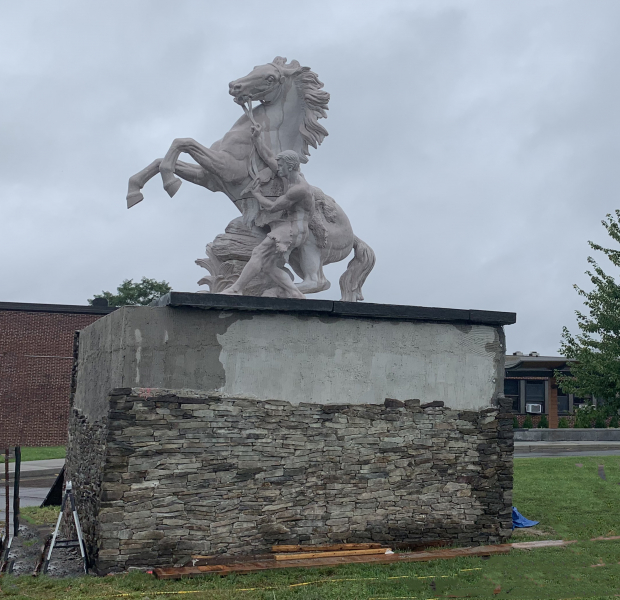
A second historic horse statue built for Clarence Mackay, an original director of the Motor Parkway and friend of Willie K., has been restored and being installed at Roslyn High School.
The statue and its restoration was the focus of a Newsday article today "Alumni pony up-Fundraising efforts lead the charge to restore horse statue."
Enjoy,
Howard Kroplick
Historic Marly horse statue replica restored for $150G and returned to Roslyn HS grounds
By Dandan Zou [email protected] Updated September 3, 2019 6:25 PM
The century-old statue of a young tamer rearing a horse has returned to Roslyn High School, completing years of fundraising and $150,000 in restoration work that began in 2012.
“It grabs your attention,” said Owamani Magezi, a school security aide, while directing busy traffic Tuesday morning as parents dropped off their children on the first day of school. “It looks majestic. It definitely adds something to the property.”
The 12-foot-tall statue is one of a pair of sculptures — the other is in Gerry Pond Park in Roslyn — modeled after the classic Marly Horses commissioned by Louis XV for the Château de Marly outside Paris. The originals are now in the Louvre museum.
The American replicas, which each weigh several thousand pounds, were erected in 1920 at the home of financier Clarence Mackay. The white marble statues, which were placed on either side of a garden terrace facing New York City, are one of the few items that remain from Mackay’s 648-acre estate known as Harbor Hill.
The statue had to be removed in 2012 after decades of exposure to the elements left it in a ruinous state. It was held together by red straps and was missing the groom’s head, his left arm and the horse's front hooves.
The school at one point put out a call searching for the man’s head — no questions asked — to no avail. The tamer’s left arm was later discovered in storage in the school’s maintenance building.
It was the alumni who came to the sculpture’s rescue.
“On a personal level, the horse was always part of my high-school experience,” said Barbara Berke of Boston, a 1969 Roslyn High graduate who organized fundraising efforts for the statue’s restoration. "The school mascot is a bulldog. But I think if you ask, nine out of 10 people would tell you it’s a horse because it’s such a feature piece" of the school.
Berke and other graduates raised more than $100,000, accounting for two-thirds of the total cost. A couple of grants covered the rest, and the school district paid for the landscaping and the pedestal.
The statue’s formal return finally came last Thursday.
For Berke, the timing couldn’t have been better. Next month, the class of 1969 will reunite in Roslyn to celebrate the 50th anniversary of their graduation.
“The fact that this horse statue is going to be back where it was, it’s going to be so meaningful to so many people from our grade who really supported the fundraising effort to get it restored,” Berke said. “It’s amazing . . . It’s almost overwhelming.”
The statues have become “one of the symbols of Roslyn and the Town of North Hempstead,” said Howard Kroplick, former North Hempstead Town historian. “It’s one of the remembrances of the history of [the villages of Roslyn and East Hills].”
Kroplick said the Mackays hired more than 1,000 people to construct the mansion, and during its peak, close to 200 people to take care of their home, making the family one of the area's largest employers. “It was the place where [Charles] Lindbergh went to to celebrate” in 1927 after the famed pilot attended a Manhattan parade honoring his solo, nonstop transatlantic flight, Kroplick said. “The statues would be lit up," he said. "You could see the lights of New York City at the top of the west garden.”
Following Mackay’s death in 1938, the mansion fell into disrepair and was demolished in 1947. The property was sold, subdivided and developed, becoming home to hundreds of families.
More than a decade later, the two statues were separated. One was donated in 1959 to the high school, which was also part of Mackay’s estate. The other one stood in its original location, which became another family's backyard, until North Hempstead Town restored it and placed it in Gerry Pond Park in 2013.
“It has become a symbol of the school,” said Barry Edelson, the school district’s director of community relations, as he stood next to the statue as it was installed on an 8-foot-tall pedestal last Thursday. “From the 1950s until 2010s, for students, this is part of their school experience here.”
Walking past the giant statue on Tuesday, Liv Valauri, 15, was one of the few students who knew of the sculpture’s history. Her parents had told her about the statues since she was 5, and she later learned the history again in a social studies class when a teacher mentioned it. “I think it’s pretty cool,” said Valauri, of Roslyn. “I’ve always seen it. The other one is in the park . . .It just shows the history of our [village].”
The North Mackay Horse Statue at Roslyn High School

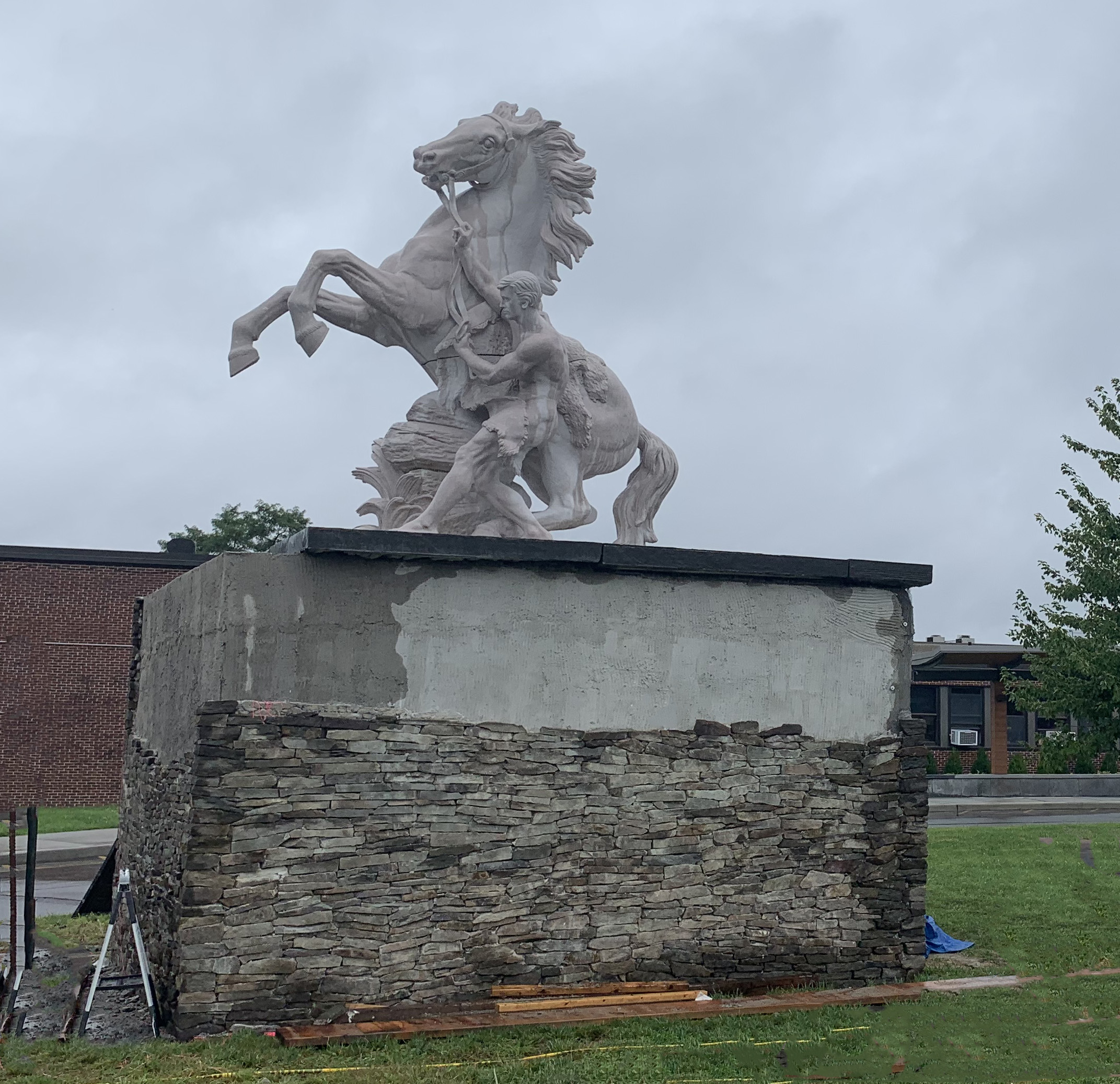
The South Mackay Horse Statue in Gerry Park
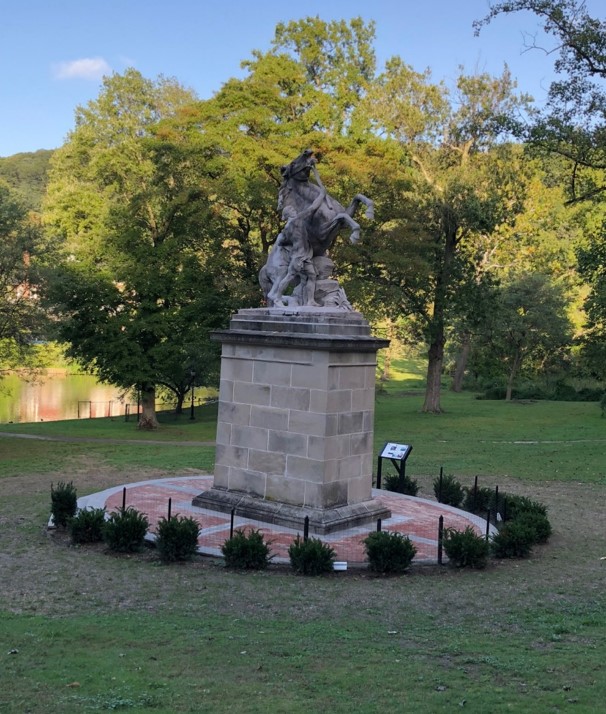
Film "The History of the Mackay Horse Statues" (8 Minutes)
Clarence Mackay
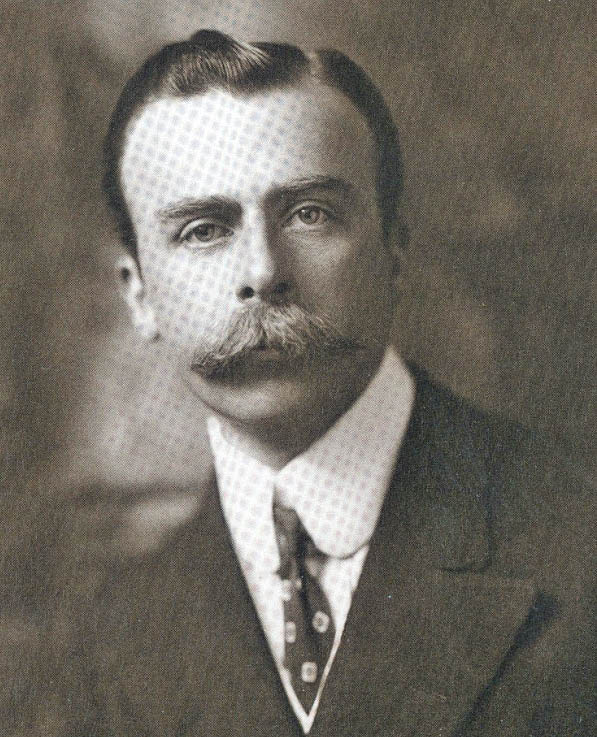
Clarence Mackay (1874-1938) was the heir to the Comstock silver fortune and was a major figure in the development of the international telegraph business. A resident of Roslyn, Mackay was involved in many of the major social and sporting events held on Long Island.
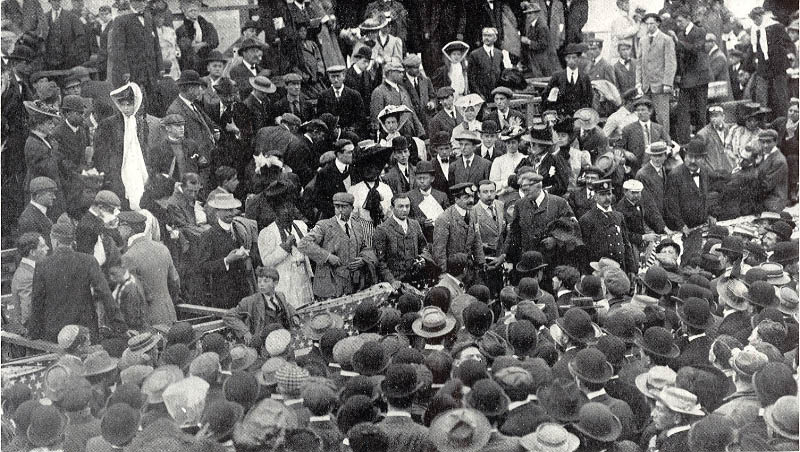
Following the conclusion of the 1906 Vanderbilt Cup Race, William K. Vanderbilt Jr. was asked to address his friends and race officials at the Westbury grandstand
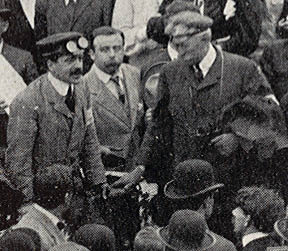
Clarence Mackay was seen in the middle between William K. Vanderbilt, Jr. (left) and Vanderbilt Race Commission Chairman Jefferson De Mont Thompson (right).
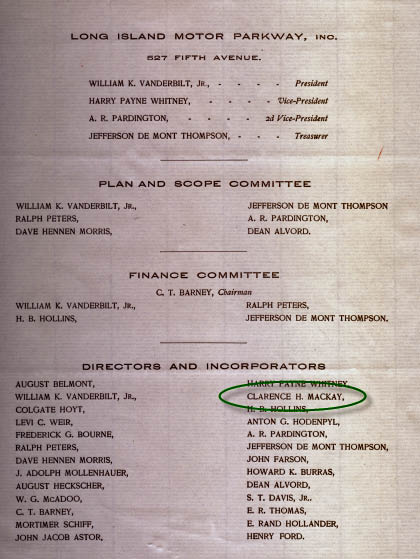
As listed in the 1906 prospectus, Clarence Mackay was an original director/incorporator of the Long Island Motor Parkway.
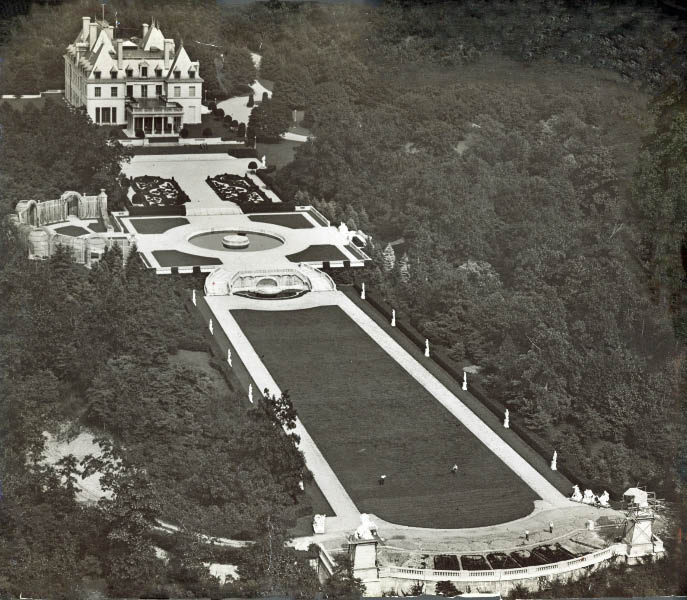
Mackay's Harbor Hill 648-acre estate in Roslyn (now East Hills) was one of the largest on Long Island with formal gardens and terraces surrounding the main house designed by Stanford White. This 1920 aerial captured the west garden of the estate nearing completion.
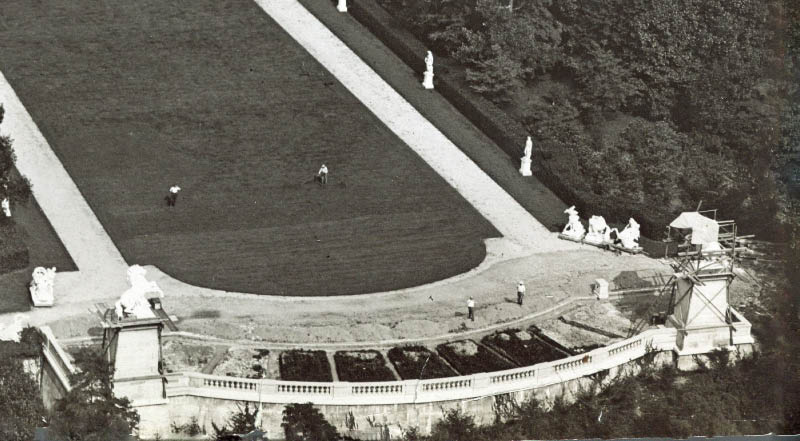
The west gardens featured two 25-foot statue/pedestals of horses and their groomsmen.
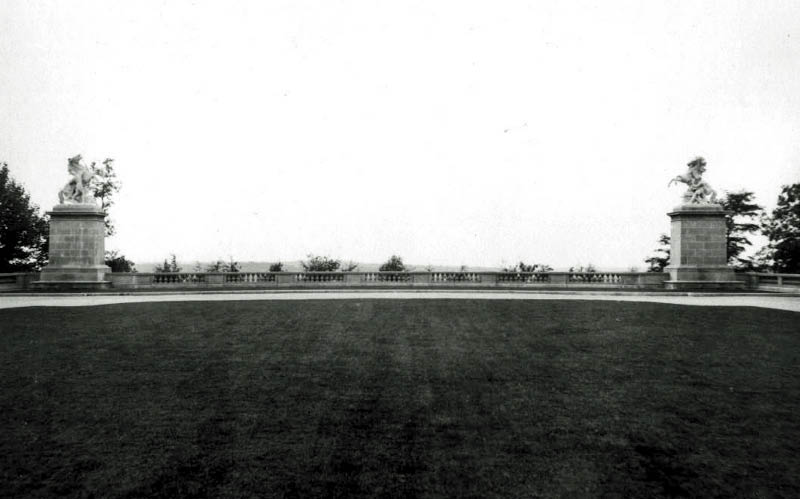
Mackay's statues were modeled after sculptures commissioned in 1739 by King Louis XV of France for his royal palace, Chateau de Marly.
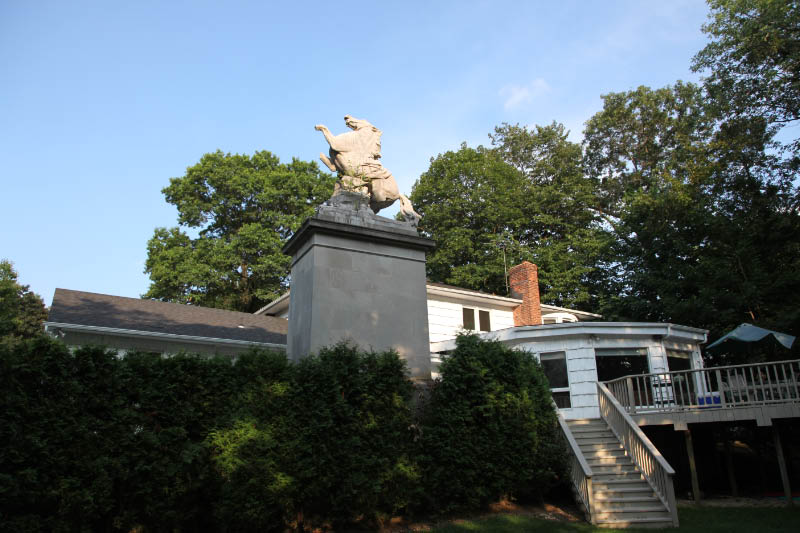
The Harbor Hill mansion was demolished to make way for new homes and the north statue was relocated to the front of Roslyn High School. The south statue remained in its original position for nearly a century in what eventually became the backyard of an East Hill’s home.

Comments
Fascinating story including the long-term determination to preserve these statues. The horses are truly spectacular. What a waste to have lost them. High five to all involved!
You realize how tall the entire Horse Statue is when it was in the backyard peering over the roof. Guess the horse had to be cut in sections because of the weight or the cranes capacity?
_______________________________________________________________
Howard Kroplick
The statues were originally built in three sections.
Love this stuff. Cool pic of the horse in the backyard. I would have never let anyone take that thing out of my yard!
Amazing to live in a location that you knew was once was a major estate. These people should all get metal detectors and dig up dropped treasures!
Water tower (pic below) still remains. Love the remnants!
Gate house remains as well, for now, but probably not much longer :(
____________________________________________________________
Howard Kroplick
The Village of East Hills now owns the Mackay Estate Gate Lodge and is planning to restore it. I am assisting them in this restoration.
The estate’s Dairyman’s Cottage is still standing in Elm Street. It was the home of lyricist Hal David for over 20 years.
Irving Berlin’s in-laws.
__________________________________
Howard Kroplick
You are correct!
This charming story brings back memories from the days-of-my youth working during the summer in the sand mines off West Shore Road to earn money for college and my dear mother’s stories from her days as a student at Roslyn HS (Bernadette Peterford, Class of ‘47). Bravo!
THANK YOU HOWARD!! I went to RHS 1965 and the horse was always there, in our yearbook and at anything to do with the school. went back in 2015 and heard about the restoring of the statue, it was and is part of that school, and town..
and
buy the way i lived just down the hill for the estate and would play up there from when i was a little tike till Junior high when they build country estates… we cause hell with them building on our play fields, hills. got shot ( buckshot i think) at by who every was in charge of the estate back in the early 1950’s
know the status well, we used to play around them, and in the spring when caterpillars would be out we would shot them off the statue with slingshots or what ever we had…
thank you for all you have done to bring the horse back
samc
old friend of gus frost
Thank you Howard for another great ‘Horsepower’ history!! Amazing that nearly 200 years after Louis XV commissioned the Marly horses, a Long Island Motor Parkway Director also commissioned ‘horsepower’ for his Roslyn estate during the ‘horseless age’ of the auto. The Marly horse and groom image now at Roslyn HS (Mackay’s North statue) was made available to the general public by the 1940s when inexpensive tabletop metal casts appeared in movie sets during the Golden Age of Hollywood and in LI homes—like the attached ‘conversation piece’ spotted on the North Shore. Now our friends know why they liked it!
______________________________
Howard Kroplick:
Corey, you are correct! Check out this YouTube video on the Marly Horses:
https://www.youtube.com/watch?v=ot7FVdZZZz8
So glad Roslyn HS students will benefit from Mackay’s inspirational Marly Horse! Adding to Hollywood stars pictured with Marly Horse sculptures at Universal Studios, I’ve attached a portrait of a special ‘star,’ the sculptor of the Marly Horses – Guillaume Cousteau the Elder (1677-1746) painted in 1730 and seen in Devereux Emmet’s Head of the Harbor home in Smithtown township. His sister Lydia Field Emmet (1866-1952) may have been inspired by the maquette (model) of the head of Cousteau’s ‘Summer’ sculpture (at Marly), seen in the print, as the pose for her White House portrait (1934) of First Lady Lou Henry Hoover painted at the request of Eleanor Roosevelt. Devereux’s nephew Robert Emmet Sherwood (1896-1955) was one of the screenwriters for Hitchcock’s thriller Rebecca (1940), which featured four pivotal scenes with Cousteau’s Marly Horses. In English film director Alfred Hitchcock’s American debut, when British-American actress Joan Fontaine runs to embrace English actor Laurence Olivier, the watching Marly Horse in the main hall is recognizable as ‘France,’ a nation that someday would be liberated because of America supporting Great Britain. Four weeks after the film’s release, Sherwood was quoted, in May 1940, declaring America was a bastion of democracy, earning him a White House position as speechwriter to President Franklin Delano Roosevelt through World War II. Cousteau and Marly ‘horsepower’ made a difference as should all public sculpture. A great inspiration for Roslyn HS!